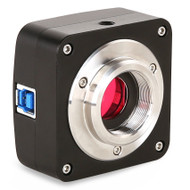Microscope Cameras - What to Consider When Choosing a Microscope Camera
Nov 20th 2023
Choosing a microscope camera involves considering several factors to ensure it meets your specific needs. Here are key considerations to keep in mind:
Compatibility
Ensure that the microscope camera is compatible with your microscope model. Different microscopes may have varying mounting options and requirements.
Camera Type
Digital vs. Analog: Decide whether you want a digital or analog microscope camera. Digital cameras are more common nowadays and allow for easy image capture and storage on a computer.
Sensor Type: Consider the type of image sensor (CCD or CMOS). CMOS sensors are more cost-effective and energy-efficient, while CCD sensors may offer better image quality in some cases.
Resolution
Choose a camera with sufficient resolution for your applications. Higher resolution provides clearer and more detailed images. Consider the level of magnification you typically use and the level of detail required for your work.
Frame Rate
For applications that require real-time viewing or recording, consider the camera's frame rate. Higher frame rates are essential for dynamic processes and live imaging.
Software and Compatibility
Check the compatibility of the camera's software with your operating system. Ensure that the software provides features such as image capture, measurement tools, and image processing.
Connection Type
Determine how the camera connects to your computer or microscope. Common connection types include USB, HDMI, and Wi-Fi. USB is widely supported and straightforward, while HDMI may offer higher data transfer rates.
Field of View
Consider the camera's field of view, especially if you work with larger samples. A larger field of view allows you to capture more of the specimen in a single image.
Light Sensitivity (Low Light Performance)
Assess the camera's sensitivity to low light conditions. This is crucial for imaging in situations where the lighting is limited.
Dynamic Range
A camera with a good dynamic range captures details in both bright and dark areas of the image. This is important for samples with varying levels of contrast.
Build Quality and Durability
Choose a camera with a durable construction, especially if it will be used in a laboratory or industrial setting. Consider factors such as the material of the camera body and its resistance to environmental conditions.
Cost
Establish a budget based on your requirements. While there are various options available, balancing features and cost is essential to finding the best fit for your needs.
Reviews and Recommendations
Read reviews from other users and seek recommendations from colleagues or experts in your field. This can provide insights into the practical performance and reliability of a specific microscope camera.
By carefully considering these factors, you can select a microscope camera that aligns with your research or imaging requirements.
Types of Digital Microscope Cameras
Education and Basic Documentation Cameras
These cameras are designed for educational purposes and basic documentation needs. They offer entry-level functionality for capturing and documenting microscope images. Typically user-friendly, they serve as excellent tools for students, educators, and professionals seeking fundamental imaging capabilities without advanced features.
Industrial Application Microscope Cameras
Specifically tailored for industrial applications, these cameras are rugged and built to withstand harsh environments. They often feature high-resolution imaging, precise measurements, and advanced analysis tools. Industrial microscope cameras are crucial for quality control, inspection, and research in manufacturing and production settings.
LCD Display Cameras
LCD display cameras come equipped with an integrated screen, eliminating the need for an external monitor. This makes them portable and convenient for fieldwork or situations where a computer setup is impractical. These cameras are versatile and suitable for various applications, providing immediate on-screen image visualization.
HD High-Definition HDMI Microscope Cameras
HD HDMI cameras deliver high-definition imaging, making them ideal for applications where detailed visualization is critical. They often support direct connection to HD monitors or screens via HDMI, ensuring that users can view specimens in stunning detail without any loss of image quality.
Wireless Cameras/Wi-Fi Cameras
Wireless microscope cameras offer the flexibility of remote operation and image sharing. Connected via WiFi, these cameras enable users to capture and transfer images wirelessly to computers or mobile devices. This feature is particularly beneficial in collaborative work environments or when working with equipment in confined spaces.
Research Grade Microscope Cameras
Research-grade cameras are designed for advanced scientific research applications. They often feature high sensitivity, low noise, and superior image quality. These cameras are suitable for demanding research tasks, such as live cell imaging, fluorescence, and other cutting-edge microscopy techniques.
Fluorescence Applications Cameras
Fluorescence microscope cameras are specialized for applications involving fluorescence imaging techniques. These cameras are equipped to capture the emitted fluorescent signals from samples, providing enhanced sensitivity for studies in cell biology, pathology, and other fields requiring fluorescence microscopy.
Scientific Grade Microscope Cameras
Scientific-grade cameras are built to meet the stringent requirements of scientific research. With advanced features like precise calibration, low-light sensitivity, and fast frame rates, these cameras excel in demanding scientific applications such as molecular biology, neuroscience, and material science.





